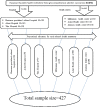Repeat-induced abortion and associated factors among reproductive-age women seeking abortion services in South Ethiopia
- PMID: 36128990
- PMCID: PMC9500254
- DOI: 10.1177/17455057221122565
Repeat-induced abortion and associated factors among reproductive-age women seeking abortion services in South Ethiopia
Erratum in
-
Corrigendum.Womens Health (Lond). 2023 Jan-Dec;19:17455057231161496. doi: 10.1177/17455057231161496. Womens Health (Lond). 2023. PMID: 38116644 Free PMC article. No abstract available.
Abstract
Introduction: Despite the advances in modern health care, maternal morbidity and mortality remain major problems in Ethiopia. Repeat-induced abortion is an indispensable contributor to this problem. Even though there are adverse effects on health, a significant proportion of Ethiopian women procure more than one abortion during their reproductive lifetime. This study aimed to determine the prevalence and associated factors of repeat-induced abortion in South Ethiopia, in 2020.
Methods: An institution-based cross-sectional study design and a systematic random sampling technique were used to collect data from 410 samples of women. Data were collected using pre-tested and semi-structured interviewer-administered questionnaires. The data were coded and entered into EpiData version 4.6.2.0 before being exported to Statistical Package for Social Sciences (SPSS) version 26 for analysis. Variables with a p-value of less than 0.05 in binary logistic regressions were exported into multivariate logistic regression analysis. Finally, variables with a p-value of less than 0.05 in the multivariate logistic regression analysis were used to declare statistical significance.
Result: The prevalence of repeat-induced abortion was found to be 35.4% (95% confidence interval = 30.7-40). Not facing a complication in prior abortion care, having more than two partners in the last 12 preceding months, perceiving abortion procedure as non-painful, having a sexual debut before the age of 18 years, and consuming alcohol have higher odds of repeat-induced abortion when compared with their counterparts.
Conclusion: The prevalence of repeat-induced abortion in Hawassa city is high compared to studies conducted in other parts of Ethiopia. Not facing complications during previous abortion care, perceiving the abortion procedure as non-painful, alcohol consumption, having multiple sexual partners, and having a sexual debut before the age of 18 years are found to increase the chance of repeat-induced abortion.
Keywords: Associated factors; Induced abortion; Repeat abortion; Reproductive-age women; South Ethiopia.
Conflict of interest statement
Figures
Similar articles
-
Determinants of repeated abortion among women of reproductive age attending health facilities in Northern Ethiopia: a case-control study.BMC Public Health. 2017 Feb 13;17(1):188. doi: 10.1186/s12889-017-4106-1. BMC Public Health. 2017. PMID: 28193200 Free PMC article.
-
Magnitude and associated factors of repeat induced abortion among reproductive age group women who seeks abortion Care Services at Marie Stopes International Ethiopia Clinics in Addis Ababa, Ethiopia.Reprod Health. 2019 Jun 4;16(1):76. doi: 10.1186/s12978-019-0743-4. Reprod Health. 2019. PMID: 31164156 Free PMC article.
-
Magnitude of late presentation for induced abortion care services and the associated factors among reproductive-age women at selected hospitals in the South Gondar district of Northwest Ethiopia in 2023: a multicentred, cross-sectional study.BMJ Open. 2024 Nov 20;14(11):e081946. doi: 10.1136/bmjopen-2023-081946. BMJ Open. 2024. PMID: 39572098 Free PMC article.
-
Contraceptive use and associated factors among women seeking induced abortion in Debre Marko's town, Northwest Ethiopia: a cross-sectional study.Reprod Health. 2020 Jun 17;17(1):97. doi: 10.1186/s12978-020-00945-4. Reprod Health. 2020. PMID: 32552736 Free PMC article.
-
Health facilities readiness to provide comprehensive abortion care and factors associated with client satisfaction in Central Oromia Region, Ethiopia: a multilevel modeling approach.Reprod Health. 2023 May 11;20(1):72. doi: 10.1186/s12978-023-01610-2. Reprod Health. 2023. PMID: 37170219 Free PMC article.
Cited by
-
Recurrent voluntary termination of pregnancy. Prevalence study and exploration of associated factors. Antioquia, Colombia, 2015 – 2021.Rev Colomb Obstet Ginecol. 2023 Dec 30;74(4):276-286. doi: 10.18597/rcog.4018. Rev Colomb Obstet Ginecol. 2023. PMID: 38421227 Free PMC article. English, Spanish.
-
Prevalence and determinants of repeat induced abortion in Ethiopia: A systematic review and meta-analysis.Heliyon. 2023 Sep 22;9(10):e20277. doi: 10.1016/j.heliyon.2023.e20277. eCollection 2023 Oct. Heliyon. 2023. PMID: 37810839 Free PMC article.
-
Individual and community-level factors associated with repeat induced abortion among women in Ghana: a multivariable complex sample logistic regression analysis of 2017 Ghana maternal health survey.BMC Public Health. 2024 May 28;24(1):1420. doi: 10.1186/s12889-024-18948-2. BMC Public Health. 2024. PMID: 38807108 Free PMC article.
-
Delays in seeking abortion and its determinants among reproductive-age women based on the Ethiopian Demographic and health survey.Heliyon. 2024 Sep 26;10(19):e38477. doi: 10.1016/j.heliyon.2024.e38477. eCollection 2024 Oct 15. Heliyon. 2024. PMID: 39430523 Free PMC article.
-
Post-abortion contraceptive uptake, choices, and factors associated with it among women seeking abortion services in Africa: a systematic review and meta-analysis.Front Glob Womens Health. 2025 Jun 16;6:1478797. doi: 10.3389/fgwh.2025.1478797. eCollection 2025. Front Glob Womens Health. 2025. PMID: 40589863 Free PMC article.
References
-
- Federal Democratic Republic of Ethiopia Ministry of Health. First trimester comprehensive abortion care. 2nd ed. 2018, pp. 10–280, https://www.arsiun.edu.et/images/health/CAC%20Partcipant's%20Manual%20J_...
-
- Singh S, Remez L, Sedgh G, et al.. Abortion worldwide. New York: Guttmacher Institute, 2017, pp. 1–86.
-
- Ipas, Inc. Induced abortion and postabortion care in Ethiopia: fact sheet. New York: Guttmacher Institute, 2017.
MeSH terms
LinkOut - more resources
Full Text Sources
Medical



